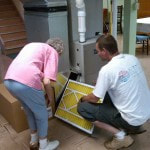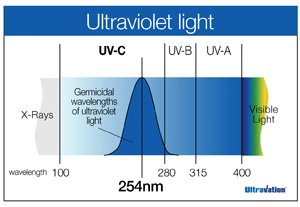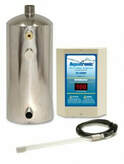YOU MIGHT BE GETTING INTO HOT WATER, BUT NOT HOW YOU WERE HOPING…Tankless water heaters They’re efficient but not necessarily economicaltaken from Consumer Reports. Heating water accounts for up to 30 percent of the average home’s energy budget. Some makers of gas-fired tankless water heaters claim their products can cut your energy costs up to half over regular storage heaters. So is it time to switch?
Probably not. Gas tankless water heaters, which use high-powered burners to quickly heat water as it runs through a heat exchanger, were 22 percent more energy efficient on average than the gas-fired storage-tank models in our tests. That translates into a savings of around $70 to $80 per year, based on 2008 national energy costs. But because they cost much more than storage water heaters, it can take up to 22 years to break even—longer than the 20-year life of many models. Moreover, our online poll of 1,200 readers revealed wide variations in installation costs, energy savings, and satisfaction. With the help of an outside lab, we pitted Takagi and Noritz gas-fired tankless water heaters against three storage water heaters. We didn’t test electric tankless heaters because many can’t deliver hot water fast enough to replace a conventional water heater if groundwater is cold. Even in areas with warm groundwater, most homeowners would need to upgrade their electrical service to power a whole-house tankless model. Our tests simulated daily use of 76 to 78 gallons of hot water. That’s the equivalent of taking three showers, washing one laundry load, running the dishwasher once (six cycles), and turning on the faucet nine times, for a total of 19 draws. While that’s considered heavy use compared with the standard Department of Energy test, we think it more accurately represents an average family’s habits. We also ran more than 45,000 gallons of very hard water through a tanked model and a Rinnai tankless model to simulate about 11 years of regular use. Here’s what else we found: Water runs hot and cold Manufacturers of tankless water heaters are fond of touting their products’ ability to provide an endless amount of hot water. But inconsistent water temperatures were a common complaint among our poll respondents. When you turn on the faucet, tankless models feed in some cold water to gauge how big a temperature rise is needed. If there’s cool water lingering in your pipes, you’ll receive a momentary “cold-water sandwich” between the old and new hot water. And a tankless water heater’s burner might not ignite when you try to get just a trickle of hot water for, say, shaving. Nor do tankless water heaters deliver hot water instantaneously. It takes time to heat the water to the target temperature, and just like storage water heaters, any cold water in the pipes needs to be pushed out. And tankless models’ electric controls mean you’ll also lose hot water during a power outage. Up-front costs are high The tankless water heaters we tested cost $800 to $1,150, compared with $300 to $480 for the regular storage-tank types. Tankless models need electrical outlets for their fan and electronics, upgraded gas pipes, and a new ventilation system. That can bring average installation costs to $1,200, compared with $300 for storage-tank models. Tankless units might need more care During our long-term testing, an indicator on the tankless model warned of scale buildup. We paid $334 for special valves and a plumber to flush out the water heater with vinegar. Many industry pros recommend that tankless models be serviced once a year by a qualified technician. Calcium buildup can decrease efficiency, restrict water flow, and damage tankless models. Experts suggest installing a water softener if your water hardness is above 11 grains per gallon. Ignoring this advice can shorten your warranty. Efficient storage models are pricey We also tested the $1,400 Vertex, a high-efficiency storage water heater by A.O. Smith. The manufacturer claims its installation costs are similar to a regular storage model. But its high cost offsets much of the roughly $70 per year the Vertex will save you. Instead, we recommend buying a conventional storage water heater with a 9- or 12-year warranty. In previous tests, we found that those models generally had thicker insulation, bigger burners or larger heating elements, and better corrosion-fighting metal rods called anodes. Posted: September 2008 — Consumer Reports Magazine issue: October 2008
1 Comment
Continuous Automatic Control – 24/7
The levels of relative humidity in your home fluctuate with the changes in outdoor temperature. An automatic humidifier continually monitors and responds to both outdoor temperatures and indoor relative humidity, delivering optimum levels of humidity throughout your home. You never have to monitor your settings or wait until you feel uncomfortable. The automatic set-it-and-forget-it control keeps your home’s humidity level exactly where you want it. for even more control, connecting your humidifier with a communicating thermostat, like Honeywell’s VisionPro 9000 IAQ stat ( model # YTH9421c1010 ) is a great way to monitor and change your comfort levels in your home to exactly what fits YOU best. Whole-House Capacity An installed whole-house humidifier adds the right amount of soothing moisture to your entire home. To achieve the same effect with a portable unit, you would need to place one in every room of your house. Minimal Maintenance, Total Convenience To maintain the performance of a portable unit, you must continually monitor the tank levels and clean and fill them regularly. A whole-house system is installed out of your living space as part of your heating system, providing quiet operation without the messy tank. Reliability A good humidifier operates so that working parts are not affected by the build-up of mineral deposits. A good humidifier is designed so that the working parts are replaced every humidifier season, eliminating the requirement to clean and scrub vital components, increasing performance and reliability. Replacement Panels can be found right on our website and shipped directly to your door! www.swensonheating.hasyourfilters.com Swenson Heating carries only the TOP QUALITY brands like APRIL AIRE & HONEYWELL humidifiers! we offer both By-pass and Steam humidification for your home! call us today for a price quote and how to make your home more comfortable this winter! THIS IS A GOOD FALL HOME MAINTENANCE REPAIR CHECK LIST I FOUND ON A SERVICE MAGIC WEBSITE. SO I THOUGHT IT WAS WORTH SHARING SINCE FALL IS APPROACHING SO FAST. Before the weather grows colder it’s important to prepare for the winter months to prevent costly damage. Below are the fall preventative home maintenance steps that every homeowner should follow. Gutters and Downspouts
Clean gutters and downspouts frequently throughout fall to prevent build up of leaves and other debris. Neglected gutters can lead to wood rot problems and pest infestations, not to mention ruined gutters. Be sure water is not coming down behind gutters and that all support brackets are securely in place. Ensure that water drains properly and doesn’t pool. Pooling can cause damage to foundations, driveways, and walkways. Windows and Doors Change summer screens to cool weather storm windows and doors. Inspect and repair any loose or damaged window or door frames. Install weather stripping or caulking around windows and doors to prevent drafts and to lower heating bills. Heating Systems Replace the filter in your furnace. Consider having a heating professional check your heating system to ensure optimal performance and discover minor problems before they turn into costly major repairs. Clean your ducts to better your heating system’s efficiency as well as to reduce household dust and to provide relief to those with respiratory problems. Plumbing To prevent pipes freezing and bursting, ensure that the pipes are well insulated. Know how to locate and turn off the water shut-off valve in case pipes do freeze. Chimney and Fireplace Call a professional in to inspect and clean your chimney. Fireplaces that are regularly used during the season should have an annual cleaning to prevent dangerous chimney fires. Test your fireplace flue for a tight seal when closed. Attic ventilation Be sure attic insulation doesn’t cover vents in the eaves to prevent winter ice dams on the roof. Be sure ridge vents and vents at eaves are free of plants and debris. Check bird and rodent screens for attic vents to prevent any unwanted guests. Landscape and Yard work Although grass appears to stop growing in the fall, the roots are actually growing deeper to prepare for winter. Now is the best time to fertilize and reseed your lawn. Prune your trees and shrubs after the leaves turn to encourage healthy growth. Trim any tree limbs that are dangerously close to power lines or the roof of your house. Heavy snow and ice can cause damage in the winter. Read more: http://www.servicemagic.com/article.show.Checklist-Fall-Preventative-Home-Maintenance.11701.html#ixzz23iE0u6ew From theNEWS Swenson contributes to these articles... THIS IS WHY THAT'S EXACTLY WHAT YOU SHOULD BE THINKING ABOUT!Let’s be honest here. Unless you’re an HVAC contractor, you’re probably not particularly interested in your heating system. And that may lead you to skimp on routine maintenance. But…if you really want to think about your heating system as little as possible, then routine maintenance is exactly what you need. According to a study conducted by the Louisiana Cooperative Extension Service, 9 out of 10 HVAC system failures are caused by dirt and dust. That means that if you hire a professional to clean and service your furnace, and you change your furnace’s air filter once a month, you are 90% less likely to have a breakdown this year! This, of course, is terrific news for your budget. Not only will you save by minimizing the possibility of a major repair, you’ll also increase your heater’s efficiency, which means lower energy bills this winter. And that means more money for that new car, the kids’ college tuition, or (just maybe) your dream vacation. But even better than that, routine maintenance leads to peace of mind. You’ll have less hassle, less worry, and a lot more time relaxing cozily in your house, doing whatever you want to do, while your heater minds its own business in your basement. So, now that you’re persuaded…what routine maintenance do you need? You should get an annual tune-up/inspection every year. A good furnace tune-up will include:
Everything on the list above should take you about half an hour a year, in total. That’s a pretty minimal amount of time in exchange for months and months of worry-free operation! PS. Everyone is suddenly interested in their heating system if it’s the first cold night and their furnace doesn’t work. This is not the time to schedule a tune-up. Do it now and beat the rush! Ultraviolet (UV) light occurs just below visible light in the electromagnetic spectrum. It is a component of sunlight and is categorized into three sections: A, B and C. The “C” band of ultraviolet light (UV-C) is a natural disinfectant and its use for sterilization is a proven technology. UV-C has been used to control microorganisms since the 1930s in medical and pharmaceutical applications, in the food and beverage industries, and in water treatment for homes, businesses and industry. UV-C application for air treatment is more recent, but it is now commonly found in many hospitals, pet centers, and office buildings. How UV disinfectsUV-C has the ability to penetrate and break-up up the DNA of microorganisms, which renders them completely harmless. It is the same process that occurs outdoors with sunlight — nature’s way of controlling airborne bacteria and viruses
History of usesThe Earth’s ozone layer allows just enough UV light from the sun through the atmosphere to keep the air from being overly contaminated with bacteria and viruses. Since realizing this, people have harnessed the power of UV light to control bio-growth anywhere it is harmful. UV is used widely in medical/pharmaceutical professions as well as the food and beverage industries to sterilize instruments, equipment, and especially water. UVC is also used for for allergy relief, fewer colds, and to add freshness to the air.
Many people don’t know that you can order just about any filter you can dream of right here on the www.SWENSONHEATING.com website! often our pricing is at or below the ” Bigbox” stores! its very simple, just click on the page, pick out the type of filter you want and order! it arrives at your home with in 48 hours usually. We carry filters for:
MERV (Minimum Efficiency Reporting Value) is the industry-standard ratings system used to measure the effectiveness of air conditioner filters. Ratings for residential and commercial AC filters typically fall between MERV 5 and MERV 12. Filters with higher MERV ratings remove more small particles from your air than lower-rated filters. The MERV system was developed in 1987 by the American Society of Heating, Refrigerating and Air Conditioning Engineers (ASHRAE), the international trade group that represents HVAC professionals. What MERV Rating is Right for Me?
Why Not Go Higher?Filters with very high MERV ratings (MERV 13+) are designed for specialized commercial uses (hospitals, clean rooms, etc.). These filters restrict air flow so much that they use substantially more electricity and can damage your air conditioner or furnace unit. What About FPR and MPR Ratings?FPR and MPR are proprietary ratings systems developed by home improvement stores and filter manufacturers. They are not directly relatable to MERV (an FPR 4 filter cannot be compared to a MERV 4 filter). These ratings systems are not endorsed or backed by ASHRAE, and we do not recommend using filters not rated under the MERV system.
You can order the right filter for you right now on our online filter store! |
AuthorSwenson Heating & Air Conditioning - Various Archives
March 2019
Categories |







 RSS Feed
RSS Feed



